Big, strong, rounded shoulders have numerous benefits besides just looking good. The deltoids are among the most important muscles in the body, as we use them in everyday life to push, pull, and lift objects over our heads.
You may be surprised to know that your anterior deltoids are the biggest of the three deltoid heads.
Your front delts are activated during all compound pressing exercises, such as push-ups, bench presses, and overhead presses.
But sometimes, we must focus more on the front delt to build a bigger, round shoulder. Building strong anterior deltoids helps improve posture and make arm movements that involve shoulder abduction more powerful and productive.
In this post, we will discuss the following give you techniques on How to grow your front delts, best exercises, execution techniques, pro tips
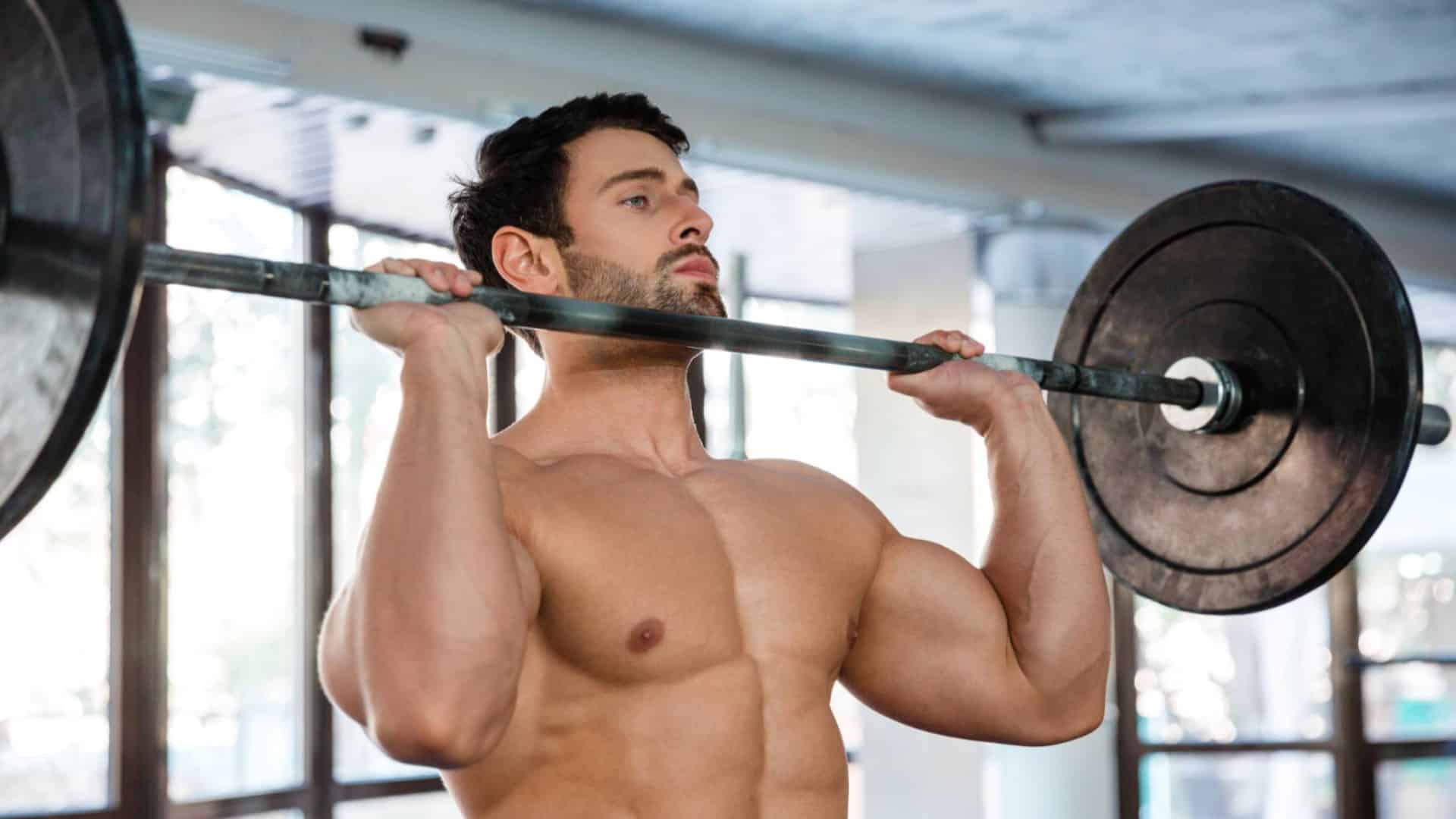
- How To Train Front Delt: 21 Best Exercises
- Barbell Anterior Deltoid Exercises
- 1. Barbell Overhead Press
- 2. Barbell Push Press
- 3. Incline Reverse-grip bench press
- 4. Behind-the-Neck Press
- 5. Barbell front raise
- 6. The Landmine Overhead Press
- Dumbbell Front Delt Exercises
- 7. Dumbbell Shoulder Press
- 8. Arnold Shoulder Press
- 8. Seated Neutral-Grip Overhead Dumbbell Press
- 9. Incline Dumbbell Press
- 10. Dumbbell Front Raise
- 11. Incline Dumbbell Front Raise
- 12. Upright Row
- 13. Plate front raise
- 14. Dumbbell Squeeze Press
- Cable Anterior Deltoid Exercises
- 15. Cable front raise
- 16. Cable Upright Row
- Bodyweight Anterior Deltoid Exercises
- 17. Push-Ups
- 18. Archer Push-Up
- 19. Pike Push Up
- 20. Handstand Push Up
- 21. Parallel Bar Dip
- Conclusion
- 12 Best Front Delt Exercises To Build Bigger Shoulder
How To Train Front Delt: 21 Best Exercises
While there are numerous exercises that target the anterior deltoid, but there are two types of exercises: presses and raises.
Presses and raises both act on shoulder flexion, which is powered by the anterior delts.
- Presses, like incline bench presses and overhead presses, are the ultimate anterior deltoid strength exercises. It is a compound exercise that targets many other muscle fibers.
- Raises like shoulder front raises and many other variations are the type of isolation exercise that mainly target the front deltoid. Front delts respond well to light weights with high volume, particularly regarding hypertrophy.
Some tips and techniques for optimizing your anterior deltoid workout and maximizing your gains are here.
- It’s essential to train this muscle group at least 1-2 a week. This will provide enough stimulus to promote muscle growth.
- To avoid plateaus and keep your muscles guessing, vary your anterior deltoid exercises regularly (after 2-3 months).
- Progressive overload the deltoid muscles by increasing resistance over time (I.e. weight, set, or reps)
- Also include exercises that work the medial and posterior deltoids for balanced shoulder development and joint stability.
- Give your anterior deltoids adequate time to recover between workouts. Overtraining can hinder progress and increase the risk of injury.
Now, let’s discuss the best anterior deltoid exercises for strengthening and building muscle mass on your shoulder using various types of fitness equipment and bodyweight exercises that you can do at home.
- Barbell Front Delt Workouts
- Anterior Delt Exercises with Dumbbells.
- Cable Anterior Deltoid Exercises
- Bodyweight Delt exercises (No Equipments).

Barbell Anterior Deltoid Exercises
Barbell exercises are a valuable tool for efficiently gaining strength. Exercise experts also point to several other benefits of barbell shoulder workouts.
- Front delt barbell exercises provide versatility and can help you strengthen virtually every muscle in the body with a wider range of resistance.
- The barbell is a simple tool, so it is easy to learn the basic lifts quickly
1. Barbell Overhead Press
The shoulder press is the best exercise for building muscle mass and strength. It remains the granddaddy of all shoulder exercises to build big, round shoulder muscles.
The seated shoulder press is the favorite shoulder exercise among bodybuilders because it builds muscle fast and is a power move.
Performing the exercise while seated upright is a stricter version than standing and prevents cheating the weight upward using momentum generated by the legs.

How To Do
- Sit on an exercise bench and grab a bar with an overhand grip.
- Bring the bar over and in front of your head, under your chin, and just above your upper chest.
- Now Press the bar straight up overhead until your arms are fully extended but not locked out.
- Slowly lower the bar back to the starting position.
Tips
- Perform a warm-up with 50% weight for 1–2 sets.
- Always perform the Shoulder Exercises before you perform the triceps.
2. Barbell Push Press
The barbell push press is a works multiple muscle groups, including shoulders, triceps, core, and legs.
It allows you to lift heavier weights overhead compared to a strict military press.
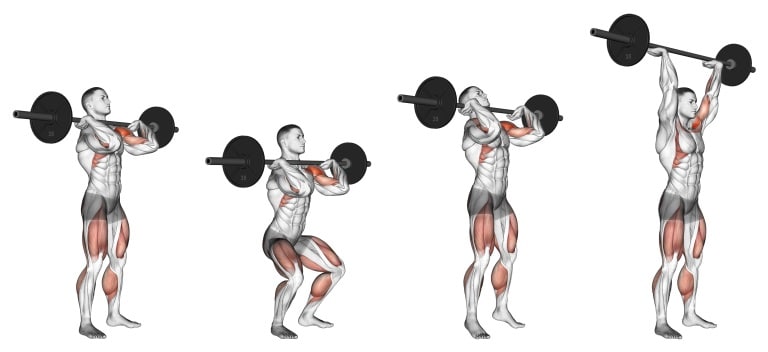
How To Do
- Place your feet hip-width apart and grasp a barbell at shoulder height with an overhand grip.
- Bend your knees and dip your hip back.
- Bend your knees slightly as if performing a shallow squat. This is the “dip” phase.
- Now, explosively extend your legs to drive upwards, generating momentum.
- As your legs extend, simultaneously press the barbell directly overhead until your arms are straight
- Slowly lower the barbell back to the starting position at your shoulders.
3. Incline Reverse-grip bench press
The incline reverse-grip bench press is a variation of the traditional bench press exercise that specifically targets the upper chest and front deltoids while also engaging the triceps and biceps.
In this exercise, you hold the barbell with an underhand rather than an overhand grip.
Start out light and ensure your thumbs are hooked around the bar for safety.

How To Do
- Set up an incline bench at an angle of around 30 to 45 degrees.
- Sit on the bench with your back against it, feet flat on the floor, and your lower back slightly bent.
- Use an underhand grip, slightly wider than shoulder-width apart, to grasp the barbell.
- Lift the barbell off the rack and hold it above your chest with extended arms.
- Lower the barbell in a controlled manner towards the upper chest.
- Pause briefly at the bottom, then push the barbell back up to the starting position, fully extending your arms.
Tips
- Hold a neutral spine throughout the movement to prevent injury.
- Perform press in a controlled manner.
- Exhale on pushing movement, and inhale when returning to the starting position.
- Contract the chest muscles at the top of the movement.
4. Behind-the-Neck Press
Behind the neck press stimulates all three heads of the shoulder and recruits the triceps, traps, and rhomboids.
If you do not have a fair amount of shoulder mobility, it is not recommended to perform this exercise.

How To Do
- Sit on an exercise bench and place the barbell to just below shoulder height.
- Elevate the barbell overhead by fully extending your arms while breathing out.
- Hold the contraction for a second and lower the barbell back to the starting position by inhaling.
- Do 8-10 reps and 3-4 sets.
Tips
- Don’t bounce the bar off your neck. Perform the exercise in a slow and controlled manner.
- Perform a warm-up with 50% weight for 1–2 sets.
- Keep your elbows flared out, aligning with the shoulders or slightly behind.
5. Barbell front raise
The barbell front raise is an effective exercise for targeting the anterior deltoids as you can perform it in various grip widths and hand positions.
The barbell allows you to overload the muscles more than you could with dumbbells.
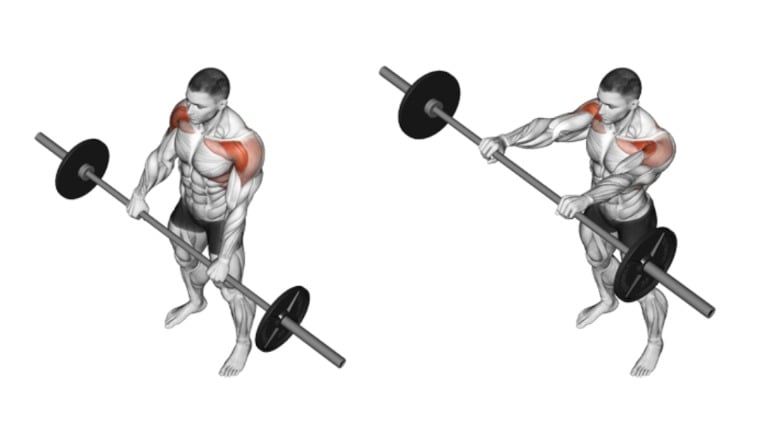
How To Do
- Stand with your feet shoulder-width apart and grasp a barbell with an overhand grip.
- Hold the barbell in front of your thighs, palms facing down, and your hands slightly wider than shoulder-width apart.
- Keep your back straight, engage your core, and slightly bend your elbows.
- Lift the barbell up slowly in front of you. Make sure your arms are parallel to the ground or slightly higher.
- Pause briefly at the top of the movement, then lower the barbell back down to the starting position.
Tips
- Maintain a neutral back and engage your core.
- Keep a controlled motion and avoid jerky movements.
6. The Landmine Overhead Press
The Landmine overhead press is a compound exercise that targets the shoulders, triceps, and chest muscles.
It is not a popular exercise, yet it provides many benefits for progressing your anterior deltoid and upper chest.
As it is performed in a standing position, it increases core involvement and can improve core stability and abdominal muscle strength.

How To Do
- Stand holding the weighted end of the barbell with both hands in front of your chest.
- Make sure the barbell is wedged securely in a landmine device or corner.
- Your feet should be level and shoulder-width apart.
- Press the barbell overhead by extending your arms, exhaling as you push the weight up.
- Pause briefly at the top of the movement with your arms fully extended.
- Lower the barbell back down to the starting position in a controlled manner while inhaling.
Tips
- Hold a neutral spine throughout the movement to prevent injury.
- Ensure that the barbell is stable.
- Brace your core, keep your back straight, and maintain a slight bend in your knees.
Dumbbell Front Delt Exercises
There are many advantages to doing front delt exercises using dumbbells, such as:
- Dumbbells require more balance than barbells or machines, which can lead to greater muscle fiber recruitment.
- Allow unilateral training, increase core stability, and improve muscular imbalances.
- Provide a greater variety, preventing physical and mental burnout.
- Allow for a greater range of movement (ROM).
7. Dumbbell Shoulder Press
The dumbbell overhead shoulder press is an excellent variation of the barbell shoulder press. The fact is that the dumbbells allow a full range of motion.
It is a fundamental compound exercise that primarily targets the deltoid muscles, specifically the anterior (front) and medial (side) delts.
It also engages the triceps and stabilizes the core and upper back muscles.

How To Do
- Start by sitting on a bench or standing tall with feet shoulder-width apart.
- Hold the dumbbells at shoulder level, palms facing forward, and elbows bent at 90 degrees.
- Press the dumbbells overhead by extending your arms.
- Pause briefly at the top of the movement with your arms fully extended but without locking out your elbows.
- Lower the dumbbells back down to shoulder level.
8. Arnold Shoulder Press
The Arnold shoulder press is a popular exercise named after the legendary bodybuilder Arnold Schwarzenegger.
It stands out from the crowd as the best exercise with the best range of motion for shoulder muscles.
It provides a wide range of motion as you lower the dumbbells well down in front, achieving the maximum stretch other shoulder exercises lack.

How To Do
- Sit on a bench or standing tall with feet shoulder-width apart.
- Hold the dumbbells at shoulder level with your palms facing your body.
- Begin the movement by pressing the dumbbells overhead while simultaneously rotating your palms away from your body.
- As you press upward, rotate your palms until they face forward.
- Pause at the top and then reverse the movement by rotating your palms back towards your body as you lower the dumbbells back down to the starting position.
Tips
- Keep a controlled motion and avoid jerky movements.
- Do not lock your arms overhead.
8. Seated Neutral-Grip Overhead Dumbbell Press
The neutral grip allows for a more natural and comfortable hand position, promoting balanced activation of the deltoid muscles.
But, using a neutral grip is also more challenging and makes for a great variation since it still works the same muscle.

How To Do
- Sit on a bench with your feet firmly planted on the floor.
- Hold a pair of dumbbells at shoulder height.
- Begin with your palms facing each other and elbows just below shoulder level.
- Push the weights straight up, stopping just short of locking out your elbows.
- Then, control the dumbbells all the way down until your upper arms are parallel to the floor or slightly lower.
Tips
- Keep your back and neck neutral.
- Do not lock out your elbows.
- Always warm up before training heavily to prevent shoulder discomfort.
9. Incline Dumbbell Press
Incline dumbbell press exercise is an excellent way to develop the middle and the upper pectoral muscles. It also targets the front deltoid.
Moreover, dumbbells demand better coordination, forcing the stabilizing muscles (tricep) to assist as well.

How To Do
- Lie back on an incline bench. Ensure the bench is adjusted to 30–45 degrees on an incline.
- Clean the dumbbells and lift them straight overhead. Feel a good chest squeeze at the top.
- Lower the dumbbells and feel a good chest muscle stretch at the bottom.
- Hold for a second, then press the dumbbell back to the starting position.
Tips
- Exhale while pushing dumbbells upwards, and do so in a controlled manner.
- Vary bench angles to hit different angles of the chest.
10. Dumbbell Front Raise
The dumbbell front raise is one of the best isolation exercises for isolating the front deltoid muscle.
This exercise can be done with a pair of dumbbells in the standing or sitting position. The seated version requires strict form and prevents cheating.
It is also possible to perform them in an alternating manner or with both hands together.

How To Do
- Stand holding a pair of dumbbells across the front of your thighs.
- Your feet are shoulder-width apart, and your knees are slightly bent.
- Raise one dumbbell (say right hand) in front of you until it reaches just above shoulder level.
- Now lower the weight (of the right hand) while raising the left in front of you.
- Perform this exercise in this alternating manner.
Tips
- Pause momentarily at the top, then slowly lower the dumbbell back to the starting position.
- Concentrate on training the front delts. Lift dumbbells before you; do not raise them outside the body.
11. Incline Dumbbell Front Raise
When you do a front raise in an inclined position, this makes it harder. There are many ways to do it.
- You may either maintain a neutral grip, use a pronated (overhand) grip, or start with a neutral grip.
- You may perform the incline dumbbell front raise with both arms or one arm at a time.
- Alternate between the different variations.
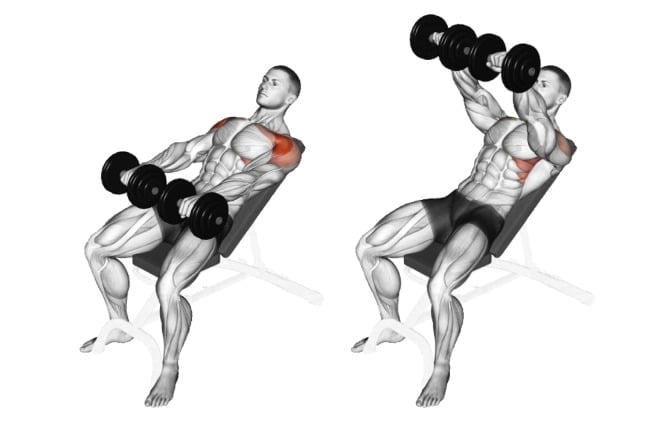
How To Do
- Set the bench at 45 degrees inclined. Lie on the bench and both feet are firmly pressed on the ground.
- Hold two dumbbells in front of you with an overhand grip and arms extended.
- Exhale and raise the dumbbells up towards your head while keeping your arms straight.
- Continue until your arms are diagonal at a 45º angle to the ground.
- Inhale and lower the dumbbells down, remembering to keep your arms fully extended.
- Now, return to the starting position.
Tips
- Make sure your back is always in contact with the bench.
- Pause momentarily at the top, then slowly lower the dumbbell back to the starting position.
- Keep a controlled motion and avoid jerky movements.
12. Upright Row
The upright row is a compound exercise primarily targeting the deltoid, trapezius, biceps, and upper back muscles.
You can do it with barbell, dumbbells, cable, or Smith Machine to perform Upright Rows.
Upright rows can also be performed with both narrow and wide grips.
- The narrow grip focuses on the Trapezius.
- The wider grip focuses on the entire shoulder girdle.
- Moreover, the wider grip allows some cheating movement, thereby allowing you to lift more weight.

How To Do
- Stand upright with your feet shoulder-width apart.
- Grasp dumbbells with an overhand grip.
- Allow the dumbbells to hang in front of your thighs with your arms fully extended.
- Pull the dumbbells upward in a vertical motion by raising your elbows toward the ceiling.
- As you lift, focus on squeezing your shoulder blades together and keeping dumbbells close to your body.
- Continue lifting until the dumbbells reach chest level or slightly below.
- Pause briefly at the top, then lower the bar under controlled motion until it returns to its starting position.
Tips
- Avoid using excessive momentum or swinging to lift the weight.
- Keep your core engaged, and maintain a straight back.
13. Plate front raise
The Plate front raise exercise is a variation of the traditional barbell front raise that increases forearm strength while targeting your frontal deltoids.
It’s best to keep the weight moderate to ensure the safety of the shoulder joints.
If you are lifting heavy weights, it will significantly challenge your core, especially your lower back. Therefore, you should gradually increase weight to give your lower back time to adjust.

How To Do
- Stand up straight, holding a weight plate in front of your thighs with both hands.
- Your hands should be at the three and nine o’clock positions.
- Raise the plate up until your arms are parallel with the ground.
- Pause, and then slowly lower the weight back to the starting position.
Tips
- Maintain a neutral back and engage your core throughout the exercise.
- Keep a controlled motion and avoid jerky movements.
14. Dumbbell Squeeze Press
The dumbbell squeeze press is one of the most effective pressing exercises which targets the inner chest and front delt.
During the squeeze press, the dumbbells are kept in contact with each other at all times, and you’re actively squeezing them inward (against each other) as hard as possible.

How To Do
- Take the dumbbells in each of your hands, and lay down on the bench.
- Place the dumbbells together side by side, and lift them up over your chest.
- Lower them down together, touch the chest, and then push the dumbbells back up.
Tips
- Breathe out on the way up.
- Maintain more tension through the pecs by not locking out the elbows entirely.
Cable Anterior Deltoid Exercises
The cable front delt exercises offer an effective way to train the front shoulder; let’s take a look at some other benefits of anterior delt workouts with a cable machine.
- They are a great alternative if you experience joint discomfort during the barbell exercises.
- The cable changes the angle of the movement enough to limit the amount of stress on the joints.
- They are more evenly distributed, and you have more of a constant load.
- They offer almost unmatched versatility because you can easily change the load, angle, grip, and body positioning.
- The cable setup gives your muscles almost uninterrupted time under tension and a massive pump.
15. Cable front raise
The cable front raise is useful because it provides constant tension on the front delt as you move the weight through the range of motion.
You can also perform the cable front raise using a rope attachment or a single stirrup, one arm at a time.
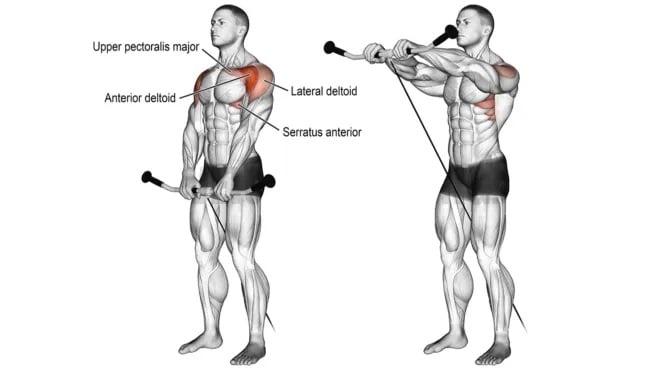
How To Do
- Attach a straight bar to a low cable pulley.
- Grab the bar using a shoulder-width or wider overhand grip.
- Stand close to the pulley with your body upright, your shoulders pulled back.
- Exhale as you pull the bar up the front of your body until the bar is at shoulder height.
- Hold for a count of two. Inhale as you lower the bar to the starting position.
Tips
- Keep your shoulders back, chest out, and body upright.
- Pause for a moment at the top position.
- Try not to bounce at the top of the movement, allow the shoulders to flex and then lower slowly.
16. Cable Upright Row
Cable upright rows are an exercise that nearly everyone can do using various grip widths. It effectively targets many of the large muscles in the upper back and shoulders.
Cable machines keep tension on the muscles throughout the entire range of motion, ultimately increasing muscle activation and hypertrophy.

How To Do
- Attach a straight bar to a low cable pulley.
- Grab the bar using a shoulder-width or wider overhand grip.
- Stand close to the pulley with your body upright, your shoulders pulled back.
- Exhale as you pull the bar up the front of your body until it reaches your lower or middle chest level.
- Do not pull the bar up any higher. Hold for a count of two.
- Inhale as you lower the bar to the starting position.
Tips
- Bend slightly at the knees and stand with feet shoulder-width apart.
- Keep your shoulders back, chest out, and body upright.
Bodyweight Anterior Deltoid Exercises
You can simply and effectively train your front deltoid muscle by doing these bodyweight shoulder exercises at home, and you do not need any equipment for this.
There are many other benefits of training at home, such as:
- No gym members are required.
- Provide more flexibility as you can train as per your schedule.
- Required limited space.
17. Push-Ups
The Push-Up is the best bodyweight calisthenics exercise to build your entire upper body, shoulders, chest, and arms. Check how to do them correctly and blast your muscles at home or the gym.
It is used to be done to build muscle and strength in the chest, shoulders, and tricep.
For the Beginner, push-ups must be part of the chest and shoulder workout.

How To Do
- Lay face down on the ground with your legs straight, and arms supporting your upper body.
- Raise yourself off the ground, straightening your elbows and your arms.
- Raise until your elbows are locked, and pause momentarily at the top.
- Take a slow, sustained motion to lower your body until your chest is very close to the ground.
Tips
- Keep your elbows close to your body.
- For more variations, you do incline push-ups and ups.
Know More: 20 Different Types Of Push Ups For Mass And Strength
18. Archer Push-Up
In the Archer push-up, your arms are wider than usual. As you lower your body, you move most of your weight to one hand, while keeping your other hand straight.
You have to maintain a tight, steady, and controlled body to perform it.

How To Do
- Start in a standard push-up position with your hands slightly wider than shoulder-width apart and elbows completely locked out.
- Maintain a strong core position and shift your upper body toward your right side.
- Pull your right chest toward your right hand as you bend your right elbow.
- As you lower toward the right side, allow your left arm to straighten.
- Your left arm should be fully extended, forming a straight line from your shoulder to your hand.
Tips
- Don’t let your hips raise.
- Make sure your body is in the straight line from head to the feet.
19. Pike Push Up
Pike Push-ups aka shoulder push-up is a variation of the push-up that increases strength and stability in the shoulders and triceps.
The pike push-up looks like a mash-up of Downward-Facing Dog and Dolphin Pose, and this move can build major strength.
Perform this exercise in a more upright position to target the shoulders more than the chest.

How To Do
- Start in a standard push-up position with your hands slightly wider than shoulder-width apart and elbows completely locked out.
- Lift the hips up and back until your body forms an inverted V shape.
- Keep arms and legs as straight as possible.
- Slowly lower the top of your head towards the ground.
- Once your head is about to contact the ground, pause for a second.
- Then slowly push back until your arms are straight, and you’re in the inverted V position.
Tips
- Make sure you maintain control throughout the movement.
Related Post: 5 Best Shoulder Push-Ups To Build Strength & Mass
20. Handstand Push Up
The handstand push-up also called the vertical push-up is a type of push-up exercise where the body is positioned in a handstand.
To prepare the strength until one has built adequate balance, the feet are often placed against a wall, held by a partner, or secured in some other way from falling.
Handstand push-ups require significant strength, as well as balance and control if performed freestanding.
Handstand push-ups increase the load on the triceps brachii muscles significantly over regular push-ups, having the arms hold almost 100% of the body’s weight rather than an average of 60 to 70% during normal push-ups.

How To Do
- Place hands about 6-12 inches away from the wall and slightly wider than shoulder width apart.
- Make sure palms are facing forward, or slightly turned out 5-10 degrees.
- Kick up into a handstand, with your heels touching the wall.
- Once you have kicked up, establish a strong, rigid midline position.
- While maintaining this position, lower yourself until the top of your head touches the floor/mat.
- Try to keep your elbows at a 45-degree angle as you lower.
- Once your head touches the floor, press up with the same tightness you had lowering yourself, until your elbows reach full extension.
Tips
- Not to arch your back and keep contracting your abs.
- Do not do this move on consecutive days. Rest for at least 2 days before trying this move again to give your body time to recover.
- Point your toes, squeeze your glutes, and grip the ground with your fingertips for a better feeling of stability.
21. Parallel Bar Dip
It is a compound exercise that primarily targets the muscles of the chest, triceps, and front part of the shoulders.

How To Do
- Hold on to the parallel bars with an overhand grip, palms facing downward.
- Lift your feet off and straighten your arms, supporting your body weight on the bars.
- Lean forward slightly while keeping your chest up and shoulders back.
- Slowly lower your body by bending your elbows until your shoulders are slightly below your elbows.
- After a brief pause at the bottom position, raise your body back up to the starting position.
Tips
- If you’re new to the exercise, you can begin with assisted dips using resistance bands or a dip machine until you build sufficient strength.
- If you need more resistance, you can hold a dumbbell between your legs.
- A little forward body bend will hit the chest muscles harder.
Want to take your gains to the next level? Discover your daily calorie needs with our free TDEE calculator
Conclusion
These anterior deltoid exercises are recommended for anyone who wants to build a bigger shoulder and who wants to gain strength.
It not only allows for targeted muscle development, but also provides an overall 3D look to the shoulder. It is easy to do and requires no more scientific details and fancy equipment. You should incorporate some exercise from these 21 exercises into your workout regimen.
To sum it up, you should hit your front delts directly at least 1 time a week, but if you’re lacking in this area, you might want to work them more often than that.
If you do these anterior deltoid exercises consistently, the results will speak by themselves.
References
- Adel Elzanie and Varacallo, M. (2023). Anatomy, Shoulder and Upper Limb, Deltoid Muscle.
- Smita Maruvada, Madrazo-Ibarra, A. and Varacallo, M. (2023). Anatomy, Rotator Cuff.
- Campos YAC, Vianna JM, Guimarães MP, Oliveira JLD, Hernández-Mosqueira C, da Silva SF, Marchetti PH. Different Shoulder Exercises Affect the Activation of Deltoid Portions in Resistance-Trained Individuals. J Hum Kinet. 2020 Oct 31;75:5-14.
12 Best Front Delt Exercises To Build Bigger Shoulder

Manish brings over 10 years of hands-on experience in weight lifting and fat loss to fitness coaching. He specializes in gym-based training and has a lot of knowledge about exercise, lifting technique, biomechanics, and more.
Through “Fit Life Regime,” he generously shares the insights he’s gained over a decade in the field. His goal is to equip others with the knowledge to start their own fitness journey.
